 |
 |
|
|
Chronology 1962 - 1977
Paris Albisola 1962 – 977 Anchorage and Internationalization of his art In the year of 1962, Lam continued to travel extensively and to attend exhibitions, but he also created a number of engravings: for the new edition of Mabille's Miroir du merveilleux, along with artists Hérold, Matta and Ernst; for Images, a portfolio produced and printed at Giorgio Upiglio's print studio in Milan; for Carpentier's last book, El Reino de este mundo. Despite the changes in Paris as the Algerian War came to an end on March 18, followed by Algeria’s declaration of independence in July, the family decided to remain in Zurich where Lou Laurin-Lam gave birth to their second son, Timour, on June 6. They returned to Alibssola for the summer, the place that held the most attraction for Lam. Their evenings were spent among friends at the restaurants Il Cantinone, Mario's or at the Montparnass. Lam began looking for a house to buy and eventually found one in the Bruciati neighborhood. With some renovation to incorporate a painting studio, and work on the grounds, there would be a terraced garden with trees and an installation of his totem collection. This became Lam’s primary residence for the next twenty years. The children and the new property in no way diminished Lam's preoccupation with world events: the missile crisis in Cuba, in particular, had the whole world on edge. After a tense moment, Moscow decided to stop its operations in exchange for a promise from the United States not to invade Cuba. Lam was equally troubled and shocked by the life imprisonment of Mandela, the leader of the ANC, whose condemnation was all the more disturbing considering he had taken up arms against Apartheid, in place since 1948. In 1963, Cuba welcomed Lam back with great pomp. His friend Carlos Franqui, a guerrilla fighter who ran the rebels' radio station and their undercover newspaper, was promoted to the post of Minister of Culture. He invited Lam to the commemoration of May 1st at the Revolution Plaza. After five years of absence, Lam reconnected with his family and his close friends: Edmundo Desnoes, now the chief editor of Revolucíon and of the supplement Lunes de Revolucíon, who later wrote an essay on Lam entitled, “Lam, azul y negro;”the architect Ricardo Porro who wrote the text to accompany his exhibition at the Bibioteca Nacional José Marti; Nicolas Guillén, Lilian and Alejo Carpentier, Odilio Urfé, but also Alain Jouffroy who had come to Cuba for a short visit. He soon learned that the works he had left behind had been nationalized and integrated in the collection of the Museo de Bellas Artes and that his whole library had disappeared. On May 1st, the country received him as a hero and he was hailed as its “national painter.” Lam returned to Albissola for the summer in time to attend the annual festival of ceramics, at which he was again in the company of his friends Jorn and Fontana, but also the sculptors Agenore Fabbri and Aligi Sassu, the Polish artist Maria Papa Rostkowska and her companion, and the art critic San Lazzaro, who founded the Parisian gallery and review XXe Siècle the year before and which published one of Lam’s color lithographs, Affinités ambiguës. Lam began designing and executing a mosaic for the boardwalk in Albissola, his participation in a commissioned work involving some thirty local artists, most of them Italian. Meanwhile his engraved work was exhibited at the newly-opened Pescetto gallery. In the autumn, the family settled into an apartment on the Rue de la Convention in the 15th arrondissement – the children's education being the primary motive for choosing Paris. Every month, Lam commuted between Albissola and Paris to be with them. In January, 1964, Lam was in New York to receive the Guggenheim International Award; the prized works included in an itinerant exhibition. Shortly afterward, he was awarded the Marzotto prize in Italy. In Paris, the Lams deepened their ties with Joyce and Samir Mansour, who introduced them to their magnificent collection of Egyptian art; with the Chilean painter Enrique Zanartu, often exhibited at the Galerie du Dragon; and with the Icelandic artist Erro, who had been living in Paris since 1958. Lam followed closely the turn of international events as the Vietnam War broke out and Martin Luther King won the Nobel prize, but he was also full of sorrow at the death of Pierre Loeb in early May, the first person to have exhibited his work some twenty-five years ago in Paris. After the summer spent in Albissola in the company of Gherasim Luca, the Lam met up with Zette and Michel Leiris in Venice. They attended the first showing of the play La Tragédie du roi Christophe performed at the Fenice. Written by Aimé Césaire, it draws from the true story of Henry Christophe and of Haiti's struggle, the first colony to win its independence and to institute a republic at the end of the 18th century – full of significance for this period of decolonization. Its message held special significance for Lam, in particular its stand in relation to the post-revolutionary totalitarian regimes that had proliferated in the course of the century. On December 18, Lam participated in a sort of happening on the plaza of the Contrescarpe in Paris. Within the group of participating artists were Alechinsky, Matta, Adami, Arroyo, J.-J. Lebel and Rotella. Organized by the Italian art dealer, Ivanohe Trivulzio, they burned 13 canvases after producing photo-lithographs of each painting – a gesture to promote affordable art. 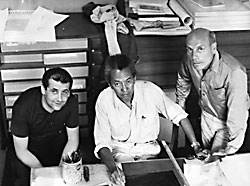
G. Upiglio, W. Lam, G. Luca, Milan, 1965
In early 1965, Lam illustrated Gherasim Luca's angst-ridden poem Apostrop'Apocalypse. He undoubtedly received an invitation from Leiris to the exhibition featuring the masterpieces in the collection of the Musée de l'Homme shortly before attending, with his wife, the showing of La Tragédie du roi Christophe at the Odéon on May 12. Present at the event were Zette and Michel Leiris, Lilian and Alejo Carpentier, Picasso, Giacometti and Alioune Diop, in what was a first showing in Paris. After the summer spent with the family in Stockholm and Falun, the Lams were invited to visit Alexandre Calder in Saché where they met his main American collector, Leonard Horwich. The American sculptor, Calder, who had discovered the region south of Tours ten years ago, had just finished building a large well-lit studio in the middle of the countryside. Lam made engravings for the review Phases, the publication Paroles Peintes II and several etchings for Feuilles éparses by René Char, an edition of his book of recollections written between 1923 and 1934 illustrated by surrealist artists. And furthermore, he participated in the 10th International Exhibition of Surrealism, L'Ecart absolu, after which he took a direct flight to Cuba, the day after Christmas 1965. Inviting him for the second time, Carlos Franqui had organized for his stay a solo exhibition of his work, a government commission and a visit of the country. To thank the painter, Cuba produced a stamp printed with one of his paintings, Composition, which belonged to the Museo de Bellas Artes of Havana. Lam executed a painting in homage to the Cuban Revolution for the Presidential Palace, El Tercer Mundo (The Third World). It became the subject of a film by Manuel Lamar, a film that had to wait many years to be released. At the occasion, Lam met Fidel Castro. In his spare time, Lam visited his sister Augustina. 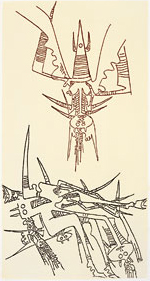
Antichamber of nature, 1964
On their way back to Europe, the Lam couple flew with Aeroflot, which had established a direct route between Moscow and Havana, stopping over in Moscow for a visit. Other travels followed in the wake of numerous personal exhibitions. A number of beautiful illustrated collections of poetry – collaborations between the artist and his poet friends – were published: L'Antichambre de la nature by Alain Jouffroy; Lessive du loup by the young poet Dominique Fourcade, who dedicated his book to René Char; Le Théâtre et les dieux by Antonin Artaud. After several days visiting Picasso in Mougins at the Mas Notre Dame de Vie, they returned to Albissola. But André Breton's death on September 28 cast its shadow on the festive spirit of traveling and visiting friends. The couple returned to Paris for the funeral, accompanied by Leiris and Duchamp. Lam and Carpentier, who was now the cultural attaché for Cuba in Paris, consoled each other with dinner guest the British writer Graham Greene, who had written a spy novel set in Cuba, a novel full of malice and intrigue on the eve of the revolution. His latest novel, The Comedians, was set in Haiti – a damning but humorous story about Duvalier's dictatorial regime, Papa Doc and his henchmen the Tontons Macoutes. Lam loved cooking for his friends, and his guests delighted in his copious, spicy Cuban dishes with black beans. On November 19, a major retrospective on Picasso opened at the Grand and Petit Palais (over 1000 works) – an event Lam would not have missed for the life of him! 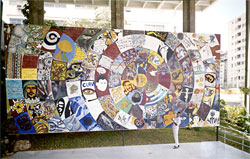
Cuba Colectiva,Havana, 1967
The year 1967 began with a number of important retrospectives – Amsterdam, Brussels and Stockholm – at which Lam was present. Upon his return, he joined Leiris in the celebrations around the publication of his book, Afrique Noire, la création artistique (in the collection “L'Univers des formes” published by Gallimard). The book is dedicated to the poet “Aimé Césaire, the porte-parole of the black world,” who was also represented in the exhibit at the Musée de l'homme, Arts primitifs, dans les ateliers d'artistes. Lam was once again a participating artist in the 23rd Salon de Mai in Paris, only this time he also made a drawing for the Salon's poster. Shortly afterward, he was asked to organize the transportation of the exhibition to Cuba. Fidel Castro, in his effort to gain international legitimacy, was seeking the backing of leftist artists and intellectuals from all over the world. It was the first time an exhibition of contemporary art was held in a socialist country. Lam worked on the project for several months with Carlos Franqui, Jacqueline Selz and Yvon Taillandier. The one hundred artists selected by Wifredo and Lou Laurin-Lam were all invited by the Cuban government. Toward the end of June, the Lam family flew to Cuba to begin preparations for the Salon, scheduled to take place from July 30 to September 7 in Havana and from September to October in Santiago. Lam was there, waiting on the tarmac, to welcome the new arrivals: Zette and Michel Leiris, Camacho, Cardénas, José Pierre, Zimbacca, Jean Schuster, Appel, César, Corneille, Erro, Hundertwasser, Pignon, Poliakoff, Vasarely, Monory, Ribeyrolles, Adami, Alechinsky, Arman, Penrose, Jouffroy, Luca, Nadeau.... The mural painting, Cuba colectiva, was created over two days (July 19 – 20), during which time the whole community joined in the festivities – an event open to everyone and a sort of happening around contemporary art, bringing together many different artistic currents: Surrealism, New Figuration, Lettrism, Situationism, CoBrA, New Realism, Pop Art, Action Painting – proof that Cuba also embraced abstract art. The mural formed a complete spiral with, in its center, a totemic drawing by Lam. Leiris, who also participated, wrote: “Friendship with Cuba, the rose of the tropics and the revolution” and later, “Lam and Franqui have kept the 'guerillero' spirit alive in their own personal way, which is the style of this communist country, strongly marked by the romantic and libertarian traditions that belong to anarchy.” 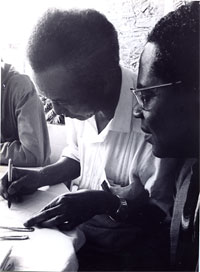
W. Lam, A. Césaire, Havana, 1967
Before leaving Cuba, Lam and Leiris were chosen by Carlos Franqui to organize the French delegation of the Congress of Intellectuals scheduled to take place in early 1968. They undoubtedly wrote up the appeal. Upon his return to France, Lam also signed the surrealist tract “For Cuba” on November 14, 1967 (published in L'Archibras n°3, March, 1968). Meanwhile, people the world over learned of El Che's assassination in Bolivia. One quote from this revolutionary figure had special significance for Lam: “The skeleton of our complete freedom is already formed. The flesh and clothing are lacking; we will create them.” While he was not able to be present at the event, Lam was represented in three of the 90 pavilions of the International Exhibition of Montreal with its theme, “Terre des hommes” – a symbolic representation of his work. Lam was once again on Cuban soil in late December, in the company of Leiris, Césaire, Jorn, Naville, Max-Pol Fouchet, Georges Limbour, Joyce Mansour, Matta, Jouffroy, René Louis des Forêts, Dionys Mascolo, Duras, Alechinsky, Edouard Pignon, Jean Schuster, Maurice Nadeau.... They all stayed at the Habana Libre hotel. Before the congress opened, they visited the country, went to shows, meetings and ceremonies, and attended Fidel Castro's speeches. On January 4, 1968, the Congreso cultural de la Habana opened with some 400 intellectuals present from all over the world. The congress was an opportunity to discuss the problems of culture in underdeveloped countries (Asia, Africa and Latin America), with freedom of expression high on the agenda. Five commissions met, followed by concerts and ballets in the evenings. All the participants signed the “Call of Havana,” against United States imperialism. At the close of the congress, Lam and his friends took a trip to his birthplace, Sagua la Grande: Michel Leiris, the writer Max-Pol Fouchet – who was at the origin of the film L'Art à Cuba directed by Gérard Pignol – and Claude Couffon, professor of Spanish and Latin American literature and translator of Lorca, Hernandez and Asturias and biographer of Nicolas Guillén. After his Cuban experience, Lam became the subject of a film by Peter Malchus, shot in Paris for German television, Der Maler Lam. While he participated in many exhibitions that year, the one at the Musée d'Art moderne de la ville de Paris, Totems et tabous with Matta and Penalba, stood out among the Parisian events. At the Salon de Mai, the collective work from Cuba was reproduced on its poster. Lam finally returned to his home in Albissola, relieved to be able to take up his work again. He did not neglect, however, his social engagements, inviting and setting up appointments with important figures in the arts: the ceramicist Tullio Mazotti, the poet Salavatore Quasimodo, the winner of the Nobel Prize in 1959, Lucio Fontana, Mario Di Micheli, a writer and art critic.... 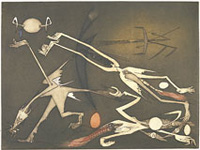
Passages pour Annonciation, 1969
In 1969, Lam accepted the project of illustrating Césaire's poems, a project that would take over ten years to reach completion. Just before the birth of their third son, Jonas, born on May 2, the family moved into a large apartment on the Boulevard de Beauséjour in the same neighborhood. The painter continued to travel and attend exhibitions, an indefatigable traveler, always eager to meet new people and to stay abreast of new films and concerts. The rest of the time, he chose to spend long periods without the family, alone in Albissola. In 1970, he was especially productive, making over 100 painted works, including the very large canvas (2.13 x 2.44m) Les Abaloches dansent pour Dhambala, dieu de l'unité. He illustrated several works: the review Opus International n°19-20; Dialogues de mes lampes by the Haitian poet Magloire-Saint-Aude; El Circulo de piedra by Carlos Franqui, a book of 15 poems which is also accompanied by the art of Erro, Jorn, Kowalski, Miró, Pignon, Rebeyrolle, Tapiès, Vedova, Cardenas, Calder and Camacho. Among the numerous exhibitions that year, Lam was present at the VIIIe biennale de Menton (July 1 – September 15), for which he designed the poster, dedicated to its Latin American artists. In October, Lam's assorted dishes and plates were exhibited in Milan, La Porcellena di Wifredo Lam, all commissioned and made at the Pietro Ruggero de la Didone Ceramice studio. One of the first major monographs written by his friend Michel Leiris was published in Milan in Italian. The family began planning a trip to Egypt. In 1971, Lam was present at the commemoration of the 30th Anniversary of the American Rescue Committee to show his gratitude to the man who had made it possible for him to leave occupied France: Varian Fry. Other memories from that period surfaced as he learned of the death, on April 6, of the composer Igor Stravinsky, whom he had met in Cuba during the war. Lam made a number of sculptures in Albissola – a sort of revival of his first artistic impulse way back in Havana in 1918. In 1971, a number of artistic creations were dedicated to Lam, most notably the film, Wifredo Lam : la recherche du point suprême by Daniel Lecomte. 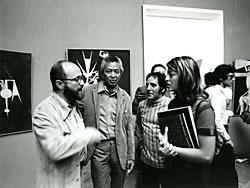
Biennal of Venice, P. Alechinsky, W. Lam, Ortega, Venice, 1972
After an exhibition of his sculptures in Paris in 1972, Lam and Leiris attended the inauguration at the Musée national des Arts et Traditions populaires, which itself had just been inaugurated. This “Louvre of the people” was created by their friend Georges-Henri Rivière. Open from June 11, the 36th Venice Biennial consecrated a hall to Lam's painting which was very well received by the press. The journalist Gianni Cavazzini considered him to be, alongside Alechinsky, the best artist of the year. Lam illustrated various works by his writer friends: his engravings adorned André Pieyre de Mandiargues's Croiseur Noir; his drawings the text by Leiris “Pour Wifredo” that appeared in the journal Ephémère. A poem by Lam, “Lumière,” was reproduced in Alain Jouffroy's book dedicated to the artist, Lam, la conquête de l'unité perdue. 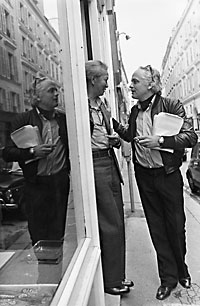
W. Lam, A. Jouffroy, Paris, 1973
As the Vietnam War came to an end in January, 1973, Lam made 6 lithographs to accompany Dominique Agori's poems collected in Le Regard vertical; designed the frontispiece of El Incendio by José Herrera Petere; and in L'Emerveillé merveilleux, he illustrated a poem by René Char. He also participated in two collective portfolios, one in homage to Miró and the other to Picasso, who had just died. Deeply saddened by the death of his friend and forever grateful to him for his encouragement right from the start, for his friendly welcome on their first meeting in 1938, Lam wrote a piece in his honor entitled, “Mon amitié avec Picasso” (My friendship with Picasso) for the newspaper L'Humanité. But equally painful was the parting of his dear friend Jorn, who died in the hospital of Aarhus in Denmark on May 1st. On his way to Albissola, he visited Avignon and the Palais des Papes to see the Picasso exhibit. Once settled down to work, he painted over 250 paintings, as an intense working period began, interrupted only by the documentary being filmed on his life and work: Wifredo Lam: Ett konstnärs porträtt by Barbro and Günes Karabuda for the Swedish radio and television. Again, the painter followed closely and anxiously the course of international events with Pinochet's coup d'état on September 11, overturning Salvador Allende, Chile's president since 1970. And closely on its heels, the news of Neruda's death on September 23, in a clinic in Santiago, his house sacked and his books burnt. Lam wasted no time in helping the victims of the military putsch in Chile by making a silk-screen to accompany the album Chili 11 septembre - 11 latino-américains, published by the France-Latin America Committee. Lam watched On vous parle du Chili, a documentary by Chris Marker in which Salvador Allende is interviewed by Régis Debray. And for a change of scene, the family spent the Christmas holidays in India. The painter was again the subject of a film in 1974, Lam o l'animado grafismo, by Mario Carbone that took place both at the painter's house in Albissola and at Giorgio Upiglio's print studio in Milan. He created several lithographs for Le Feu vert, published in Italy. In Paris, he created a series of lithographs to accompany Pleni Luna by José Pierre and Ragnar von Holten. While he painted a great deal, some 100 canvases, and continued to exhibit as many, he spent the school holidays with the family. Lam organized a trip to the North Cape for the summer with the children and to India for Christmas, inviting a number of friends to join them. In India, he filmed constantly, fascinated by the sites and the technology of the moving camera – the Benares Shoals and Mahabalipuram (southern India), on the coast, in the north at Pondicherry where they visited the ruins of the sanctuary consecrated to Shiva and Vishnu from the 12th century. A passion for ceramics (1975) 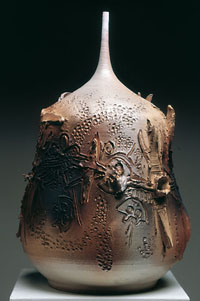
Vase I, 1975
A book on his drawings was published in 1975, prefaced by Philippe Soupault who wrote of his works as “mediations on bolts of lightning.” The painter became involved in an altogether personal artistic project, the album Le nouveau Nouveau monde de Lam, prefaced by Jouffroy, a sublime book in black and white with illustrations, photos and extracts – all carefully assembled and chosen by the artist. He wrote several short passages about his own personal reminiscences. After a family trip to Greece, during the Easter holidays, Lam once again settled down in Albissola. He took another absence from his paints, however, to work in the San Giorgio studio. He began working intensively on ceramics, enjoying the technique – man's most ancient creative act, blending earth and fire – because of “the creative freedom of the art.” He completed over 300 pieces which were no sooner put on exhibit at the Ceramics Museum of Albissola. Gianna Lombardi made a documentary for the Italian-Swiss television. 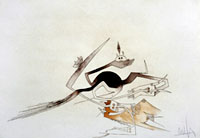
Sans titre, Contre une maison sèche, 1974
Lam's production of graphic work remained abundant. In 1976, a number of the works he had illustrated were published: Contre une maison sèche and De la sainte famille au droit à la paresse by René Char; then El ultimo Viaje del buque fantasma, a novel by the Colombian writer Gabriel García Marquez. A succession of collective and personal exhibitions followed, most notably at the Galerie Albert Loeb where his work was accompanied by African and Oceanic art objects. In Paris, Lam again joined the Sunday gatherings at Châtillon with his dear friend Césaire, and became a regular at the Cuban embassy with Carpentier and his guests. It was also an important year for monographs, published internationally by authors Sebastia Gasch, Pierre Gaudibert, Max-Pol Fouchet and Wieland Schmied. A year too of great loss with the deaths of Ernst, Man Ray and Calder. For the Easter holidays of 1977, the family and their friends went to Kenya, an opportunity for Lam to discover Black Africa. But the Africa he encountered was too “touristy” – far from the “original” experience he had hoped for. He was invited to Cuba in June for the presentation at the Museo de Bellas Artes of his most recent lithographs. He reconnected with Gabriel García Marquez and with his old friend René Portocarrero. The director of Humberto Solas began a documentary on Lam's life for Cuban television. The inauguration at the Musée d'art moderne at the Centre Georges-Pompidou brought him back to Paris. He was invited to participate in two other exhibitions: 100 oeuvres nouvelles 1974-1976, followed by Paris-New York. And then it was Spain that called him back, to Alicante, Madrid and Barcelona, where he did a personal hanging of his work. Now that Franco was dead, he decided to stay longer in the country – the country for which he had fought. Anne Egger (Translation by Unity Woodman) |